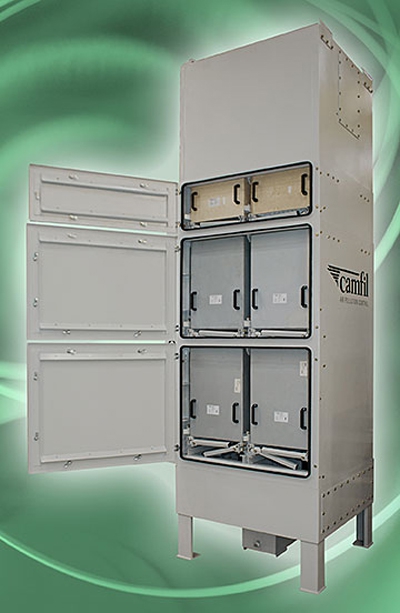
The new Handte Oil Expert oil mist collector from Camfil Air Pollution Control (APC) is built to operate "24/7" for greater productivity, reduced maintenance and long service life. The Handte Oil Expert is designed to withstand the most challenging applications that utilize lubricant oils to cool machining operations, meeting even the stringent specifications of the automotive industry. It offers separation efficiencies up to 99.97 percent on 0.3µm and larger particles, reliably handling ultra-fine, hard-to-capture oil mist and fume particles.
Key features include:
A first-stage coarse mesh filter separates out large particles and chips, followed by two stages of Camfil APC "CoaPack" diffusion filters: a pre-filter and fine filter that are the heart of the Handte Oil Expert collector. Media separators in the CoaPacks allow optimum airflow through the filters while providing maximum usable media area within a compact space. This design combines high efficiency separation performance with self-cleaning capability via drainage of the separated cooling lubricant. Benefits include reduced energy consumption, extended filter life of three years on average, and enhanced protection of the optional HEPA final filter, which may be used for removal of ultra-fine mists and/or clean air recirculation.
The compact but sturdy modular design allows optimum installation flexibility. Four basic modules with different air flows may be combined in a large central system. Processes served include turning, drilling, milling, roughing, grinding, broaching, honing, rolling, deep-drawing and pressing. Units can be delivered ready for "plug and play" without any additional assembly required at the installation site.
The operation of the Handte Oil Expert is practically maintenance-free. Filter changes are clean and easy and require no tools. The closed filter cassettes eliminate worker exposure to the oil-soiled filter media and are lightweight compared to competitive cartridges.
Contact Details
Related Glossary Terms
- broaching
broaching
Operation in which a cutter progressively enlarges a slot or hole or shapes a workpiece exterior. Low teeth start the cut, intermediate teeth remove the majority of the material and high teeth finish the task. Broaching can be a one-step operation, as opposed to milling and slotting, which require repeated passes. Typically, however, broaching also involves multiple passes.
- diffusion
diffusion
1. Spreading of a constituent in a gas, liquid or solid, tending to make the composition of all parts uniform. 2. Spontaneous movement of atoms or molecules to new sites within a material.
- gang cutting ( milling)
gang cutting ( milling)
Machining with several cutters mounted on a single arbor, generally for simultaneous cutting.
- grinding
grinding
Machining operation in which material is removed from the workpiece by a powered abrasive wheel, stone, belt, paste, sheet, compound, slurry, etc. Takes various forms: surface grinding (creates flat and/or squared surfaces); cylindrical grinding (for external cylindrical and tapered shapes, fillets, undercuts, etc.); centerless grinding; chamfering; thread and form grinding; tool and cutter grinding; offhand grinding; lapping and polishing (grinding with extremely fine grits to create ultrasmooth surfaces); honing; and disc grinding.
- milling
milling
Machining operation in which metal or other material is removed by applying power to a rotating cutter. In vertical milling, the cutting tool is mounted vertically on the spindle. In horizontal milling, the cutting tool is mounted horizontally, either directly on the spindle or on an arbor. Horizontal milling is further broken down into conventional milling, where the cutter rotates opposite the direction of feed, or “up” into the workpiece; and climb milling, where the cutter rotates in the direction of feed, or “down” into the workpiece. Milling operations include plane or surface milling, endmilling, facemilling, angle milling, form milling and profiling.
- modular design ( modular construction)
modular design ( modular construction)
Manufacturing of a product in subassemblies that permits fast and simple replacement of defective assemblies and tailoring of the product for different purposes. See interchangeable parts.
- turning
turning
Workpiece is held in a chuck, mounted on a face plate or secured between centers and rotated while a cutting tool, normally a single-point tool, is fed into it along its periphery or across its end or face. Takes the form of straight turning (cutting along the periphery of the workpiece); taper turning (creating a taper); step turning (turning different-size diameters on the same work); chamfering (beveling an edge or shoulder); facing (cutting on an end); turning threads (usually external but can be internal); roughing (high-volume metal removal); and finishing (final light cuts). Performed on lathes, turning centers, chucking machines, automatic screw machines and similar machines.






